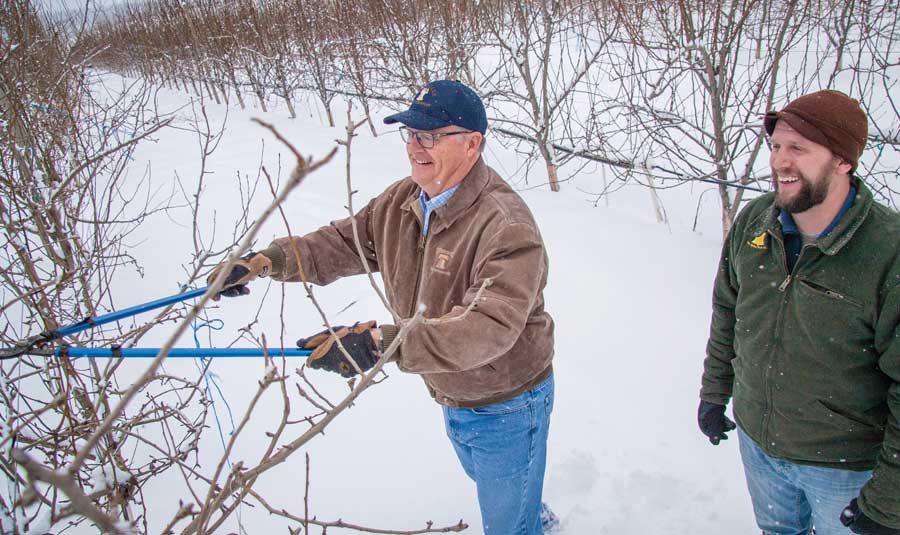
Don Gibson, left, president of the Mt. Adams Orchard Corp., evaluates pear trellises with Tim Pitz, assistant superintendent, on Jan. 5, 2016, at the company’s orchards in White Salmon. (Ross Courtney/Good Fruit Grower file photo)
When the industry standard rootstock isn’t dwarfing enough, light penetration to lower canopies becomes a problem.
That’s one of the big reasons why growers are not rushing to put up 50-acre blocks of pears on Y-trellises.
And yet, Good Fruit Grower found two hardy souls giving the system a try. Despite setbacks, both are still evaluating its possibilities and both agreed rootstock was a significant obstacle to the venture.
The pear industry standard, Old Home by Farmingdale 87, is the most precocious commercial pear rootstock available, but it is not dwarfing enough.
Aaron Clark, vice president of Price Cold Storage in Yakima, Washington, planted a block of Taylor’s Gold pears on a Y-trellis 10 years ago.
After five years, with “no more than a cardboard box of them” to show for his efforts, he cut them down and top-worked them to Golden Russet Bosc.
In the block’s third year, he harvested 30 tons per acre and thought he was on to something. “I thought the heavens had opened and I dreamed I could yield 40 tons an acre consistently,” he said. “Turns out, I can’t, or at least I haven’t so far.”
He tried replicating his early success with a 3-by-11 foot organic block of Bosc, planting 1,300 trees per acre, using OHxF.87 and 97 rootstocks. Success hasn’t come, and one of the problems he cited was light penetration.
With 2-foot open tops, his trees bloomed but didn’t set as well as he would have liked, especially in the lower parts of the tree.
He opened his tops to 4 to 5 feet, which he said gave him his best results, but his yields still fell short of his 40-ton goal.
Currently, his orchard is averaging 25 tons per acre, maxing out at 35 tons per acre, and his mature blocks are making just the average.
Clark is unhappy with his rootstock choices. “Since we don’t have consistently productive rootstock for pears, we’ve been trying to build more budwood,” he said. “I’m not sure that is a long-term answer.”
Consumer desire for new varieties is huge, he said. “But with no rootstock, we’re stuck. So we grow the same pears my grandfather grew.”
Don Gibson, CEO of Mount Adams Orchards of White Salmon, Washington, put up a 14-acre block of Y-trellised pears, hoping to get into production faster. He achieved his goal, getting to the levels he wanted in five years.
What makes him unhappy are the system’s costs, some of which are related to vigor. Like Clark, he has experienced problems maintaining light interception to the bottom of the trees.
Training costs are another concern. “We were spending more time on training in the first years,” he said. “It also took multiple wires to tie limbs into position because limbs can have weaker calipers.”
Then, too, denser trees bring on higher fire blight risk. “If you get it, it would spread quickly,” Gibson said.
His bottom line: “We don’t have a good, dwarfing rootstock conducive to a trellis.” •
– by Dave Weinstock






Leave A Comment